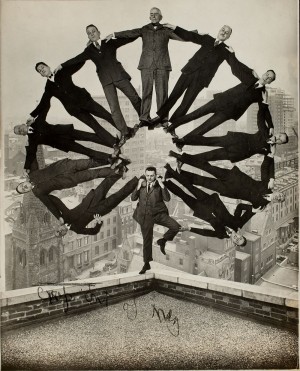‘Faking It’ at the Met: The Lie Behind Photographic ‘Truth’
“Every photograph is a fake from start to finish, a purely impersonal, unmanipulated photograph being practically impossible.” This observation, made by American photographer and artist Edward Steichen, may not seem terribly revelatory in a 21st-century digital age. In the modern world, practically any photo can be rendered into binary-coded pixels on a computer screen and distorted to the designer’s liking. Image-editing software such as Photoshop has made pictorial alteration quicker, easier and more accessible than ever before. Just trying to dodge a doctored photo on the Internet would be more difficult than making a five-year-old sit still for a family portrait. But when Steichen uttered his claim in 1903, the personal computer was over a half-century away from hitting the market and Photoshop was merely the name of any generic mom-and-pop store where locals took their film to be developed. The practice of photographic manipulation may be nearly ubiquitous in the present day, but the Metropolitan Museum of Art’s Faking It: Manipulated Photography Before Photoshop exhibition highlights that it has been prevalent well before even Steichen’s time, since the medium’s invention toward the middle of the 19th century.
The showcase, organized by Mia Fineman, the assistant curator in the museum’s department of photography, consists of approximately 200 snapshots on international loan dating from the 1840s through the early 1990s, when the computer replaced manual techniques as the main form of photographic modification. It’s an all-encompassing blanket that elucidates the different stages of fakery throughout the history of the visual medium. Methods such as retouching, overpainting, multiple exposure, sandwiched negatives, photomontage and combination printing — in which portions of multiple negatives are combined into a single picture — pervade the lot. These approaches serve to “document” events that never took place, capture the hallucinatory quality of dreams, support a political or ideological cause, and, in one particularly amusing instance, expose what Elvis would have looked like with the shaved head of a G.I. instead of his greased-up mop. In several cases, the Met enhances the presentation with entertaining before-and-after displays to highlight the extent of artists’ fallaciousness. Indeed, the depiction of a nearly empty dining table, as in Richard C. Miller’s Thanksgiving Table (1941), turns into the gastronomical haven of one laden with food — as seen on the cover of the Saturday Evening Post — before viewers’ eyes. The differences between the initial and final prints are at times fairly drastic, and petite museum plaques accompanying the visual specimens serve to educate museumgoers by outlining the darkroom sleight of hand used to transform each respective photograph.
The Met has organized the artwork into seven different sections based on the motivating factor behind the alteration of the camera image. “Picture Perfect” is the first segment in the lineup, and rightfully so — its contents deal with the infancy of graphical con-artistry, when manipulation was an attempt to make up for technical limitations inherent to early photographic processes. Because strictly black-and-white pictures didn’t emulate real-world vibrancy, photographers applied color to their prints with powdered pigment, watercolor and oil paint. Overexposed skies posed problems as well, due to photographic emulsions being more sensitive to blue and violet than other colors in the electromagnetic spectrum. Photographers like Gustave Le Gray and Carleton E. Watkins compensated by printing two negatives — one exposed for the sky and the other for land — on one sheet of paper to create flawless sceneries. Watkins’ Cape Horn, Columbia River, Oregon (1867) is a testament to the potential of this combination printing, as a featureless, washed-out sky hanging over a majestic landscape of cliffs and the Columbia River becomes one filled with white, fluffy clouds complementing the beauty of the panorama below.
Other notable categories include “Novelties and Amusements,” which delves into the genre of trick photography, popular among darkroom enthusiasts in the late 19th and early 20th centuries, and “Mind’s Eye,” a tribute to the metaphysical subject matter of the Surrealist movement, founded in Paris in 1924. Combined, these segments give a comical and bizarre twist to the exhibition — railcar-sized ears of corn, a man juggling his own head, and a gigantic, eyelash clad eye staring into an empty room factor into the mix. These groupings also provide some of the more striking and captivating shots in the whole Faking It showcase. For example, Yves Klein’s Leap into the Void (1960) captures the seemingly suicidal plunge of a man, who’s nearly horizontal with the pavement while plummeting from a 15-foot ledge (an undoctored image portrays a group of men wielding a safety net below him). Yet more peculiar is Wanda Wulz’s lo + gatto (1932), a curious photo that blends together one negative of the artist and one of the family cat, giving birth to a hybrid creature that seems oddly human yet strangely animal — and, since it’s staring directly into the camera lens, makes the viewer almost feel like a piece of catnip.
(Article continued on next page)

